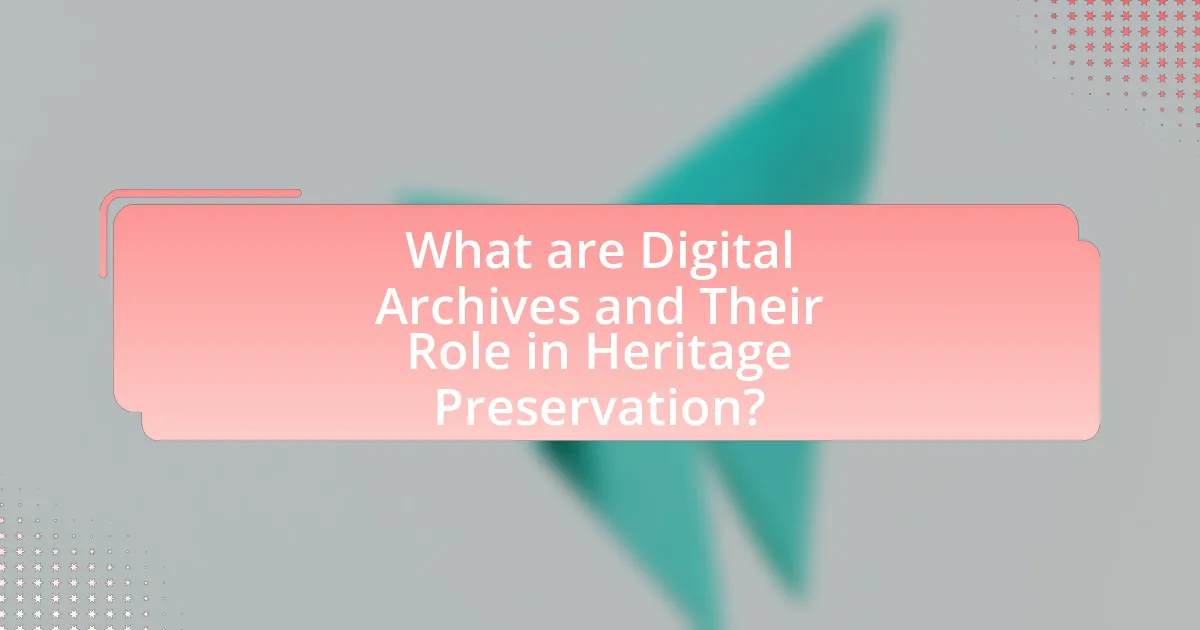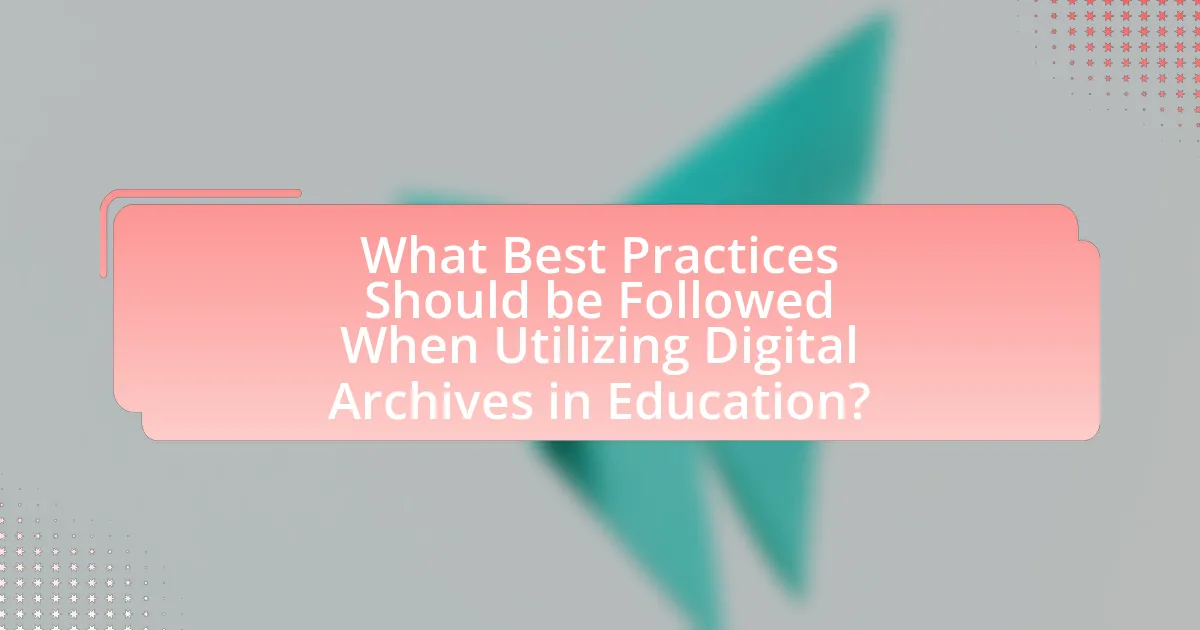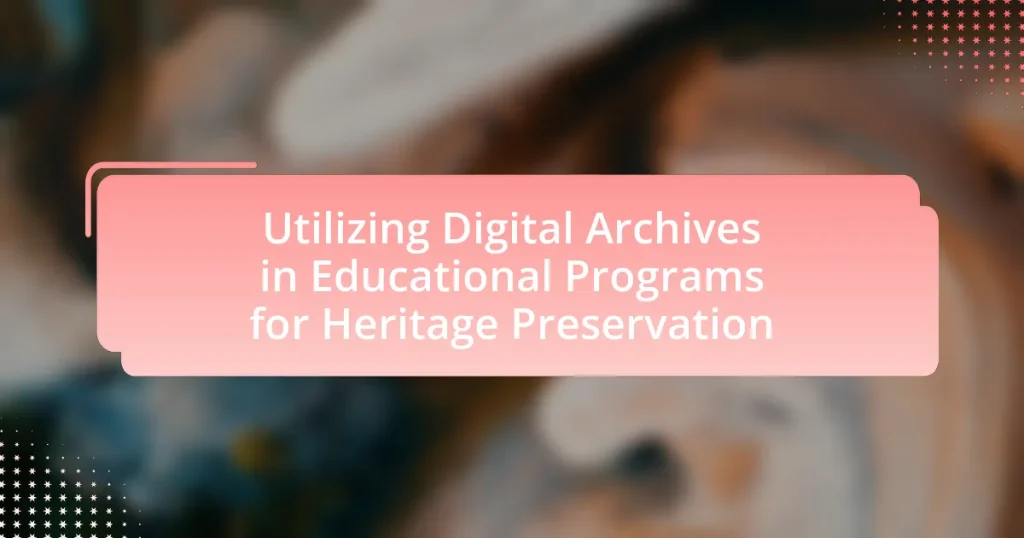Digital archives are essential collections of digitized materials that play a significant role in preserving cultural heritage by providing access to historical documents, photographs, and multimedia resources. This article explores how digital archives contribute to heritage preservation, enhance accessibility, and support educational programs that foster community engagement and awareness. It discusses the types of materials found in digital archives, effective strategies for integrating these resources into educational curricula, and the challenges educators face in utilizing them. Additionally, it highlights best practices for selecting appropriate digital archives and assessing their impact on student learning, along with available resources and training for educators.

What are Digital Archives and Their Role in Heritage Preservation?
Digital archives are collections of digitized materials that preserve and provide access to historical documents, photographs, audio recordings, and other cultural artifacts. Their role in heritage preservation is crucial, as they enable the safeguarding of cultural heritage by making these resources accessible to a wider audience while protecting the original items from deterioration. For instance, the Library of Congress has digitized millions of items, allowing global access and ensuring that important historical documents are preserved for future generations. This accessibility fosters educational programs that promote awareness and appreciation of cultural heritage, thereby enhancing community engagement and historical understanding.
How do digital archives contribute to the preservation of cultural heritage?
Digital archives significantly contribute to the preservation of cultural heritage by providing accessible, organized, and long-term storage of historical documents, artifacts, and multimedia. These digital repositories enable the safeguarding of cultural materials against physical degradation, loss, or destruction, as evidenced by initiatives like the Digital Public Library of America, which aggregates millions of digitized items from libraries and museums across the United States. Furthermore, digital archives facilitate global access, allowing diverse audiences to engage with cultural heritage, thus promoting education and awareness. For instance, the Europeana project offers access to over 50 million digitized items from European cultural institutions, enhancing the visibility and appreciation of cultural heritage worldwide.
What types of materials are typically found in digital archives?
Digital archives typically contain a variety of materials, including text documents, images, audio recordings, video files, and datasets. These materials serve to preserve and provide access to historical records, cultural artifacts, and scholarly research. For instance, text documents may include manuscripts, letters, and reports, while images can encompass photographs, maps, and artwork. Audio recordings often feature oral histories or music, and video files may include documentaries or recorded events. Datasets can provide quantitative information relevant to research and analysis. The diversity of these materials supports educational programs aimed at heritage preservation by offering rich resources for study and engagement.
How do digital archives enhance accessibility to heritage resources?
Digital archives enhance accessibility to heritage resources by providing online platforms where users can easily access, search, and interact with historical documents and artifacts. These archives eliminate geographical barriers, allowing individuals from diverse locations to engage with cultural heritage materials that were previously restricted to physical locations, such as museums or libraries. For instance, the Digital Public Library of America offers access to millions of photographs, manuscripts, and other resources, significantly broadening the audience and facilitating educational opportunities. Additionally, digital archives often include metadata and advanced search functionalities, which improve the discoverability of specific items, thus fostering greater engagement and research opportunities in heritage preservation.
Why are educational programs important for heritage preservation?
Educational programs are crucial for heritage preservation because they foster awareness and understanding of cultural significance among individuals and communities. By educating people about the value of heritage, these programs encourage active participation in preservation efforts, leading to increased support for initiatives that protect historical sites and traditions. Research indicates that communities engaged in educational outreach are more likely to invest in conservation projects, as seen in various case studies where local heritage initiatives thrived following educational campaigns.
What role do educational programs play in raising awareness about heritage?
Educational programs play a crucial role in raising awareness about heritage by providing structured learning experiences that highlight the significance of cultural history and traditions. These programs often incorporate digital archives, which serve as accessible resources for students and the community, allowing them to engage with historical documents, artifacts, and narratives. For instance, studies have shown that students who participate in heritage education programs demonstrate increased knowledge and appreciation for their cultural backgrounds, as evidenced by a 2019 report from the National Endowment for the Humanities, which found that 75% of participants felt more connected to their heritage after engaging with educational initiatives. By fostering this connection, educational programs not only enhance individual understanding but also promote community involvement in heritage preservation efforts.
How can educational programs foster community engagement in heritage preservation?
Educational programs can foster community engagement in heritage preservation by integrating digital archives into their curricula, allowing participants to access, analyze, and contribute to the preservation of local history. By utilizing digital archives, educational programs provide hands-on experiences that encourage community members to explore their cultural heritage, thereby increasing awareness and appreciation for preservation efforts. For instance, programs that involve students in digitizing local historical documents or artifacts not only enhance their learning but also empower them to take an active role in safeguarding their community’s heritage. Research indicates that such participatory approaches lead to higher levels of community involvement and investment in heritage preservation initiatives, as evidenced by case studies where local schools collaborated with heritage organizations to create digital exhibits showcasing their community’s history.

How can Digital Archives be Utilized in Educational Programs?
Digital archives can be utilized in educational programs by providing access to a wealth of historical documents, images, and multimedia resources that enhance learning experiences. These archives facilitate interactive learning, allowing students to engage with primary sources, which fosters critical thinking and analytical skills. For instance, the National Archives offers digitized documents that educators can incorporate into lesson plans, enabling students to explore historical events firsthand. Research indicates that students who interact with primary sources demonstrate improved comprehension and retention of information, as evidenced by studies conducted by the American Historical Association. Thus, digital archives serve as vital tools in enriching educational curricula and promoting heritage preservation.
What are effective strategies for integrating digital archives into educational curricula?
Effective strategies for integrating digital archives into educational curricula include aligning digital content with learning objectives, fostering critical thinking through analysis of primary sources, and utilizing collaborative projects that engage students with archival materials. Aligning digital archives with specific learning goals ensures that the resources are relevant and enhance the educational experience. For instance, using historical documents from digital archives can help students develop analytical skills by comparing different perspectives on historical events. Collaborative projects, such as group presentations or research assignments that require students to utilize digital archives, promote teamwork and deeper engagement with the material. Research indicates that students who interact with primary sources demonstrate improved critical thinking and engagement, as highlighted in the study “Teaching with Primary Sources” by the Library of Congress, which shows that such methods enhance learning outcomes.
How can teachers utilize digital archives to enhance student learning?
Teachers can utilize digital archives to enhance student learning by providing access to a wealth of primary source materials that foster critical thinking and engagement. Digital archives contain historical documents, photographs, and multimedia resources that allow students to explore diverse perspectives and contexts. For instance, a study by the American Historical Association found that students who engaged with primary sources demonstrated improved analytical skills and a deeper understanding of historical events. By integrating these resources into lesson plans, teachers can create interactive learning experiences that encourage inquiry-based learning and promote digital literacy.
What tools and technologies support the use of digital archives in education?
Digital archives in education are supported by tools and technologies such as content management systems, digital asset management software, and cloud storage solutions. Content management systems like Omeka and DSpace facilitate the organization and presentation of digital collections, enabling educators to create interactive learning experiences. Digital asset management software, such as Adobe Experience Manager, allows for efficient storage, retrieval, and sharing of multimedia resources. Cloud storage solutions like Google Drive and Dropbox provide accessible platforms for collaboration and resource sharing among educators and students. These technologies enhance the integration of digital archives into educational programs, promoting heritage preservation through accessible and engaging learning materials.
What challenges exist in utilizing digital archives for educational purposes?
Utilizing digital archives for educational purposes presents several challenges, including issues of accessibility, digital literacy, and preservation. Accessibility can be hindered by technological barriers, such as inadequate internet access or outdated devices, which limit students’ ability to engage with digital content. Digital literacy is another significant challenge, as educators and students may lack the necessary skills to effectively navigate and utilize digital archives, leading to underutilization of available resources. Furthermore, the preservation of digital materials poses a risk; formats can become obsolete, and data loss can occur if proper archiving practices are not followed. These challenges highlight the need for targeted strategies to enhance access, improve digital skills, and ensure the longevity of digital resources in educational settings.
How can educators overcome barriers to accessing digital archives?
Educators can overcome barriers to accessing digital archives by leveraging partnerships with institutions that host these archives and utilizing available training resources. Collaborating with libraries, museums, and universities can provide educators with access to specialized knowledge and tools necessary for navigating digital archives effectively. For instance, the American Library Association offers resources and workshops aimed at enhancing digital literacy, which can empower educators to better utilize these archives in their teaching. Additionally, many digital archives provide user-friendly interfaces and support services that can assist educators in overcoming technical challenges.
What are the potential pitfalls of using digital archives in educational settings?
The potential pitfalls of using digital archives in educational settings include issues of accessibility, data integrity, and the risk of digital obsolescence. Accessibility can be limited by technological barriers, such as inadequate internet access or lack of digital literacy among students and educators. Data integrity concerns arise from the possibility of inaccurate or incomplete information being presented, which can mislead learners. Additionally, digital obsolescence poses a risk as formats and technologies evolve, potentially rendering archived materials inaccessible over time. These challenges highlight the need for careful planning and ongoing support when integrating digital archives into educational programs.

What Best Practices Should be Followed When Utilizing Digital Archives in Education?
Best practices for utilizing digital archives in education include ensuring accessibility, integrating digital resources into the curriculum, and promoting critical engagement with the materials. Accessibility is crucial; archives should be user-friendly and available to all students, including those with disabilities. Integrating digital resources into the curriculum enhances learning by providing diverse perspectives and primary sources, which can enrich discussions and assignments. Promoting critical engagement encourages students to analyze and interpret the materials, fostering skills in research and critical thinking. Research indicates that students who engage with primary sources develop a deeper understanding of historical contexts and improve their analytical skills (National Archives, 2015).
How can educators ensure the effective use of digital archives in their programs?
Educators can ensure the effective use of digital archives in their programs by integrating structured training on digital literacy and archival research methods into the curriculum. This approach equips students with the necessary skills to navigate, analyze, and utilize digital archives effectively. Research indicates that programs incorporating hands-on experience with digital archives enhance student engagement and comprehension, as evidenced by a study published in the Journal of Educational Technology & Society, which found that students who participated in such programs demonstrated a 30% increase in information retention compared to traditional methods. Additionally, establishing partnerships with digital archive institutions can provide educators access to resources and expertise, further enriching the educational experience.
What guidelines should be followed for selecting appropriate digital archives?
To select appropriate digital archives, prioritize criteria such as credibility, accessibility, and relevance to the educational program’s goals. Credibility can be assessed by examining the institution or organization behind the archive, ensuring it is reputable and recognized in the field of heritage preservation. Accessibility involves evaluating the ease of use and availability of the digital archive, including whether it is user-friendly and provides adequate support for users. Relevance pertains to the content’s alignment with the specific themes and objectives of the educational program, ensuring that the materials contribute meaningfully to heritage preservation efforts. These guidelines are supported by best practices in digital archiving, which emphasize the importance of these factors in enhancing educational outcomes and preserving cultural heritage effectively.
How can educators assess the impact of digital archives on student learning?
Educators can assess the impact of digital archives on student learning by implementing both qualitative and quantitative evaluation methods. For instance, they can analyze student engagement through surveys and feedback forms that measure interest and understanding of the material presented in the archives. Additionally, educators can track academic performance by comparing test scores and project outcomes before and after the integration of digital archives into the curriculum. Research indicates that students exposed to digital archives demonstrate improved critical thinking and research skills, as evidenced by a study conducted by the American Historical Association, which found that 75% of students reported enhanced analytical abilities when utilizing primary sources from digital archives.
What resources are available for educators interested in digital archives?
Educators interested in digital archives can access a variety of resources, including online databases, digital library platforms, and educational organizations that specialize in archival studies. Notable examples include the Digital Public Library of America, which provides access to millions of photographs, manuscripts, and other primary sources, and the American Library Association, which offers guidelines and best practices for using digital archives in educational settings. Additionally, platforms like Archive.org and Europeana provide extensive collections of digitized materials that can be utilized for teaching and research. These resources support educators in integrating digital archives into their curricula, enhancing students’ engagement with historical materials.
Where can educators find training and support for using digital archives?
Educators can find training and support for using digital archives through various organizations and online platforms dedicated to digital literacy and archival education. Notable resources include the Digital Public Library of America, which offers webinars and guides, and the Society of American Archivists, which provides workshops and online courses specifically designed for educators. Additionally, many universities and libraries offer professional development programs that focus on integrating digital archives into educational curricula, ensuring that educators have access to the necessary tools and knowledge to effectively utilize these resources.
What online platforms offer access to digital archives for educational use?
Online platforms that offer access to digital archives for educational use include JSTOR, Project MUSE, and the Internet Archive. JSTOR provides a vast collection of academic journals, books, and primary sources, making it a valuable resource for educational institutions. Project MUSE offers access to humanities and social science content from scholarly publishers, supporting research and teaching. The Internet Archive is a non-profit digital library that provides free access to a wide range of digital content, including books, audio, and video, which can be utilized for educational purposes. These platforms are widely recognized for their contributions to educational resources and heritage preservation.


